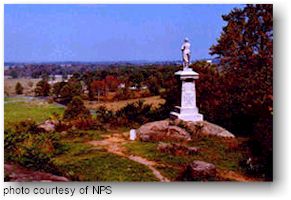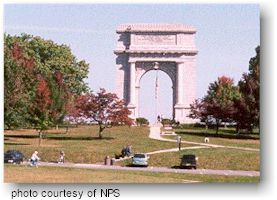


|

|
 Gettysburg National Military Park |
 Memorial Arch at Valley Forge National Historic Park |
|
Allegheny Portage Railroad National Historic Site - The Allegheny Portage Railroad was the first railroad constructed over the Allegheny Mountains. This inclined plane railroad operated between 1834-1854 and was considered a technological wonder in its day and played a critical role in opening the interior of the United States to trade and settlement. Appalachian National Scenic Trail - The Appalachian National Scenic Trail is a 2,167-mile (3,488 km) footpath along the ridge crests and across the major valleys of the Appalachian Mountains from Katahdin in Maine to Springer Mountain in north Georgia. The trail traverses Maine, New Hampshire, Vermont, Massachusetts, Connecticut, New York, New Jersey, Pennsylvania, Maryland, West Virginia, Virginia, Tennessee, North Carolina and Georgia. Delaware and Lehigh National Heritage Corridor - Settlement patterns, from Native Americans to today's immigrants, continue to change the patterns in the tapestry known as the Delaware and Lehigh National Heritage Corridor. It began because of the magnificent scenery and the discovery of the widest range of natural resources found anywhere in the world. Delaware Water Gap National Recreation Area - This park preserves 40 miles of the middle Delaware River and almost 70,000 acres of land along the river's New Jersey and Pennsylvania shores. At the south end of the park, the river cuts eastward through a scenic water gap in the Appalachian Mountains. Canoeing, camping, fishing, swimming, hiking; viewing wildlife, geologic features and natural scenery. Edgar Allan Poe National Historic Site - This is the 1840s home of Edgar Allan Poe, one of America's finest and most influential writers. The small brick house now connected to 530 North Seventh Street was Poe's home, 1843-1844. During the entire six years (1838-1844) that Poe lived in Philadelphia, he attained his greatest successes as an editor and critic, and he published some of his most famous tales, including, "The Gold Bug," "The Fall of the House of Usher," "The Tell-Tale Heart," and "The Murders in the Rue Morgue". Eisenhower National Historic Site - The farm designated Eisenhower National Historic Site is the only place President and Mrs. Dwight D. Eisenhower ever called home. In 1950, the Eisenhowers, looking forward to retirement, purchased the Allen Redding farm adjoining Gettysburg National Military Park. The original 189 acre farm was transformed by stages into the 230 acre country estate of the 34th President of the United States. During his Presidency, President and Mrs. Eisenhower used the farm as a weekend retreat, a refuge in time of illness, and a comfortable meeting place for world leaders. Fort Necessity National Battlefield - Colonial troops commanded by 22 year old Colonel George Washington were defeated in this small stockade at the "Great Meadow". This opening battle of the French and Indian War began a seven year struggle between Great Britain and France for control of North America. Great Britain's success in this war helped pave the way for the American Revolution. Friendship Hill National Historic Site - The park preserves the country estate of Albert Gallatin, a Swiss emigrant who served his adopted nation during the early years of the republic. Gallatin is best remembered for his thirteen year tenure as Secretary of the Treasury during the Jefferson and Madison administrations in which he reduced the national debt, purchased the Louisiana Territory and funded the Lewis & Clark exploration. Gallatin's accomplishments and contributions to the late 18th and early 19th century American Republic are highlighted through exhibits and programs presented in his restored Friendship Hill house. Gettysburg National Military Park - Located 50 miles northwest of Baltimore, the small town of Gettysburg, Pennsylvania was the site of the largest Civil War battle ever waged in the Western Hemisphere. North Country National Scenic Trail - The North Country National Scenic Trail links scenic, natural, historic, and cultural areas in seven northern states. The approximately four thousand mile long trail includes a variety of hikes from easy walking to challenging treks. When completed, through the efforts of many people, the trail will become the longest continuous hiking trail in the United States. Potomac Heritage National Scenic Trail - The designation of a Potomac Heritage National Scenic Trail corridor in 1983, an amendment to the National Trails System Act, is being used by communities in Virginia, Maryland, the District of Columbia and Pennsylvania to develop and make connections among trails, historic sites and a range of recreational and educational opportunities. |
Gloria Dei Church National Historic Site - Gloria Dei (Old Swedes') Church was built between 1698 - 1700 and is the oldest church in Pennsylvania. The Swedes preceded the English to this part of America, arriving here in 1646. For nearly two centuries, this church was a mission of the Church of Sweden. As Swedes were absorbed into the general American population, Gloria Dei became English speaking and was admitted into the Episcopal church in 1845. The Church is owned and maintained by its congregation and contains important historic relics and artifacts. Hopewell Furnace National Historic Site - Hopewell Furnace National Historic Site is one of the finest examples of a rural American 19th century iron plantation. The buildings include a blast furnace, the ironmaster's mansion, and auxiliary structures. Hopewell Furnace was founded in 1771 by Ironmaster Mark Bird. The furnace operated until 1883. Hopewell Furnace consists of 14 restored structures in the core historic area, 52 features on the List of Classified Structures, and a total of 848 mostly wooded acres. Hopewell Furnace National Historic Site is surrounded by French Creek State Park which preserves the lands the furnace utilized for its natural resources. Independence National Historic Park - Independence National Historical Park, located in downtown (called "Center City"), Philadelphia, is often referred to as the birthplace of our nation. At the park, visitors can see the Liberty Bell, an international symbol of freedom, and Independence Hall, a World Heritage Site where both the Declaration of Independence and the U.S. Constitution were created. In addition, the park interprets events and the lives of the diverse population during the years when Philadelphia was the capital of the United States from 1790 to 1800. A section of the park where Benjamin Franklin's home once stood is dedicated to teaching about Franklin's life and accomplishments. Spanning approximately 45 acres, the park has about 20 buildings open to the public. Johnstown Flood National Memorial - The rain continued as men worked tirelessly to prevent the old South Fork Dam from breaking. Elias Unger, the president of the South Fork Fishing and Hunting Club, was hoping that the people in Johnstown were heeding the telegraph warnings sent earlier, which said that the dam might go. When it finally happened, at 3:10 P.M., May 31, 1889, an era of the Conemaugh Valley's history ended, and another era started. Over 2,209 people died on that tragic Friday, and thousands more were injured in one of the worst disasters in our Nation's history. Johnstown Flood National Memorial is located in southwestern Pennsylvania, about 10 miles northeast of Johnstown. The park contains nearly 165 acres and preserves the remains of the South Fork Dam and portions of the former Lake Conemaugh bed. Steamtown National Historic Site - Experience a part of American railroading that hasn't existed for nearly a century-the era of the steam locomotive! Steamtown National Historic Site was established on October 30, 1986, to further public understanding and appreciation of the role steam railroading played in the development of the United States. Thaddeus Kosciuszko National Memorial - Born of impoverished landed gentry in the eastern Polish province of Polesie on February 4, 1746, Thaddeus Kosciuszko, a military engineer, became one of the 18th century's greatest champions of American and Polish freedom. The house at the corner of Third and Pine Streets, where Thaddeus Kosciuszko resided during the winter of 1797-1798, serves as a memorial to his life and accomplishments. Upper Delaware Scenic and Recreational River - As a part of the National Wild and Scenic Rivers System, Upper Delaware Scenic and Recreational River stretches 73.4 miles (118.3 km) along the New York-Pennsylvania border. The longest free-flowing river in the Northeast, it includes riffles and Class I and II rapids between placid pools and eddies. Valley Forge National Historic Park - Few places evoke the spirit of patriotism and independence, represent individual and collective sacrifice, or demonstrate the resolve, tenacity and determination of the people of the United States to be free, as does Valley Forge. Here, despite setbacks and hardships, the Continental Army under General George Washington's leadership built upon its growing military competence. Through intensive training, the army honed its skills and became a professional force that marched on to victory over the British and secured America's independence in 1783. Chesapeake Bay Gateways Network - First thoughts of the Chesapeake Bay often bring up images of crabs and oysters. But, as the largest estuary in North America, the Chesapeake Bay has touched and influenced much of the American story – early settlement, commerce, the military, transportation, recreation and more. The Bay and its surrounding 64,000 square mile watershed hold a treasure trove of historic areas, natural wonders and recreational opportunities. |
|
|
|
For more information visit the National Park Service website |
|||